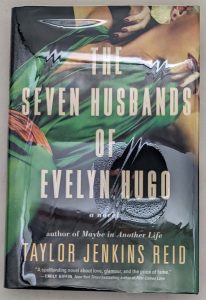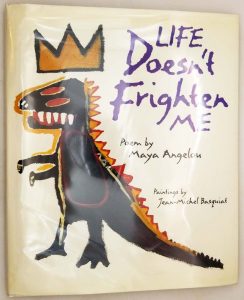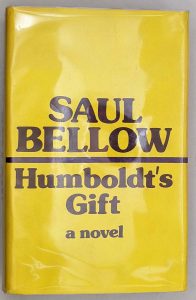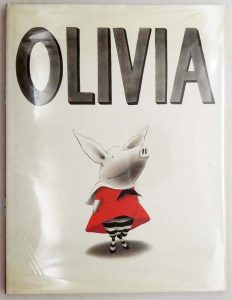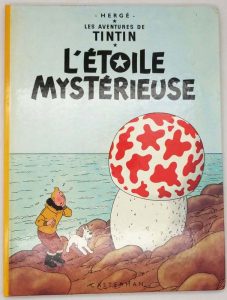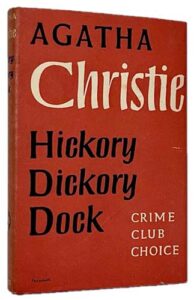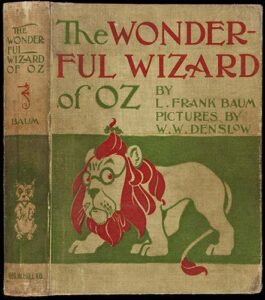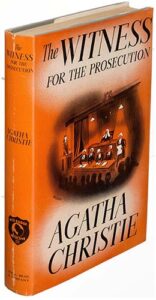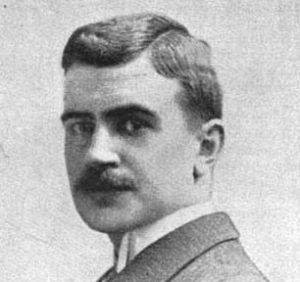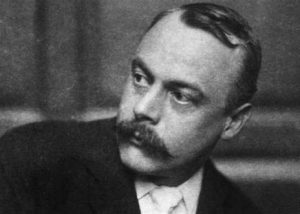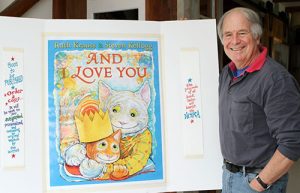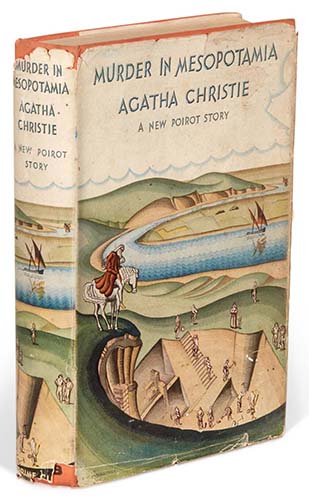
Murder in Mesopotamia is a work of detective fiction by British writer Agatha Christie, first published in the UK by the Collins Crime Club on 6 July 1936 and in the US by Dodd, Mead and Company later in the same year. The UK edition retailed at seven shillings and sixpence (7/6) and the US edition at $2.00. The cover was designed by Robin McCartney.
The book features Belgian detective Hercule Poirot. The novel is set at an archaeological excavation in Iraq, and descriptive details derive from the author’s visit to the Royal Cemetery at Ur where she met her husband, Sir Max Mallowan, and other British archaeologists.
References in other works
- In Death on the Nile, Poirot credits his experience on the expedition with developing his methods in detection. He muses: “Once I went professionally to an archaeological expedition—and I learnt something there. In the course of an excavation, when something comes up out of the ground, everything is cleared away very carefully all around it. You take away the loose earth, and you scrape here and there with a knife until finally your object is there, all alone, ready to be drawn and photographed with no extraneous matter confusing it. This is what I have been seeking to do—clear away the extraneous matter so that we can see the truth…”
Plot Summary
[SPOILER ALERT]
Nurse Amy Leatheran arrives at an archaeological dig near Hassanieh, Iraq, to assist the Swedish-American archaeologist, Dr Eric Leidner, in caring for his seemingly-neurotic wife, Louise. During her initial days, Amy learns that Louise was married before to a German named Frederick Bosner. Fifteen years ago, during the Great War, Bosner was arrested for being a spy within the US State Department, and sentenced to death; he escaped custody, but died later in a train crash. Louise reveals that she received death threats claiming to be from Frederick, whenever she was attracted to another man; these stopped when she married Leidner three years ago, until recently. A week later, after receiving another threatening letter, Louise is found dead in her bedroom in the archaeologists’ compound near the dig site. Dr Giles Reilly determines she was struck by a very heavy, blunt object.
An initial investigation, led by Captain Maitland, cannot find the murder weapon, but confirms someone on the dig must have committed the murder. Reilly learns that his friend Hercule Poirot is travelling in Iraq, and so contacts him for help. When Poirot arrives, he notes that the bedroom has only one point of entry, that the only window in the room was shut and barred, and that a rug near a washstand has blood on it. Anne Johnson, a colleague of Leidner, claims she heard a cry, yet is unsure about it. Reilly’s daughter Sheila remarks that the victim had the attention of every man, especially one of Leidner’s old friends Richard Carey. Poirot takes an interest in the story Louise told Nurse Leatheran about her first husband; he wonders if Bosner, or possibly his much-younger brother William (presumably still living but whereabouts unknown) is somehow among team. Two men – epigraphist Father Lavigny and drug-addicted historian Joseph Mercado – are the right age to be Frederick. Furthermore, three younger men – dig assistants Bill Coleman and David Emmott, and photographer Carl Reiter – are the right age to be William. Reiter in particular is of German-American ancestry, and was tormented by Louise for his shyness and clumsiness. However, he seems to have an alibi. Poirot is also intrigued to find that the letters Louise received were apparently in her own handwriting.
Following Louise’s funeral, Nurse Leatheran meets with Miss Johnson on the compound’s roof. Johnson claims she knows how someone could have entered unseen; she does not elaborate on this further. That night, Miss Johnson unwittingly drinks a glass of hydrochloric acid which had been substituted for her usual glass of water on her nightstand. Amy attends to Miss Johnson, and hears her mention “the window” before she dies. The nurse does not believe Miss Johnson has committed suicide, and wonders if she hinted at how the acid was switched for the water. After spending a day sending telegrams, Poirot brings everyone together and reveals that both women were murdered by Dr Erich Leidner, who is, in reality, Frederick Bosner. The real Leidner died in the train crash 15 years ago – when Bosner came across his body and found his face disfigured, he switched their identities to escape the authorities.
Bosner was deeply possessive of Louise. To discourage her from forming relationships with other men, he sent her letters, which he carefully wrote out in her handwriting so the police would disbelieve her. The letters stopped after he married her twelve years later, when she no longer recognised him. When Louise became attracted to Richard Carey, Bosner decided to murder her to ensure no one else could have her. On the day of the murder, Bosner, on the rooftop, lured her to the window with a mask he had used to scare her on previous nights. Once she stuck her head out to investigate, he dropped a quern on her, which he then pulled back to the roof via a rope he had tied to it. On the pretense of checking on her, he shut the bedroom window while moving the body and the rug beneath it to where they were later found. He then used Amy as part of his alibi to divert suspicion from himself. Miss Johnson was murdered because she had begun to realise how Louise was killed.
In the aftermath of Poirot’s investigations, it is revealed that Father Lavigny is actually Raoul Menier, a dealer in stolen artifacts. As Lavigny was known to Leidner only by reputation, Menier was able to impersonate him while stealing artifacts found at the dig and replacing them with excellent copies. Thanks to warnings sent out by Poirot, Menier and his associate Ali Yusuf are arrested in Beyrouth. Sheila marries David Emmott, and Nurse Leatheran returns home to England.
Publication history
- 1936, Collins Crime Club (London), 6 July 1936, Hardcover, 288 pp
- 1936, Dodd Mead and Company (New York), Hardcover, 298 pp
- 1944, Dell Books (New York), Paperback, (Dell number 145 [mapback]), 223 pp
- 1952, Pan Books, Paperback, (Pan number 200)
- 1955, Penguin Books, Paperback, (Penguin number 1099), 219 pp
- 1962, Fontana Books (Imprint of HarperCollins), Paperback, 190 pp
The book was first serialised in the US in The Saturday Evening Post in six instalments from 9 November (Volume 208, Number 19) to 14 December 1935 (Volume 208, Number 24) with illustrations by F. R. Gruger.
In the UK, the novel was serialised as an abridged version in the weekly Women’s Pictorial magazine in eight instalments from 8 February (Volume 31, Number 787) to 28 March 1936 (Volume 31, Number 794) under the title No Other Love. There were no chapter divisions and all of the instalments carried illustrations by Clive Uptton. Several character names were different from the eventual published novel: Amy Leatheran became Amy Seymour while Mr and Mrs Leidner were surnamed Trevor.[
Murder in Mesopotamia – First Edition Book Identification Guide
The books are listed in the order of publication. While the majority of Agatha Christie’s books were first published in the UK. There are many titles that were first published in the US. The title of the book may differs from the UK edition in some cases.
| Year | Title | Publisher | First edition/printing identification points |
|---|---|---|---|
| 1936 | Murder in Mesopotamia | William Collins & Sons, London, [1936] | First edition. "Copyright 1936" stated on the copyright page. No statement of later printings. Orange cloth lettered in black. Price 7/6. |
| 1936 | Murder in Mesopotamia | Dodd, Mead & Co, NY, 1936 | First American edition. Date on the title & copyright page matches. No statement of later printings. Turqoise cloth lettered in black. Price $ 2.00. |
Note about Book Club Editions (BCE) and reprints:
UK: You can see statements of later reprint dates or of book club on the copyright page.
US: The US reprint publishers usually use the same sheets as the first edition and are harder to identify by looking at the title page or the copyright page. One may identify a BCE by looking at the DJ, which doesn’t have a price on top of the front flap and a “Book Club Edition” imprint at the bottom. If the dust jacked is clipped at both the top/bottom of the front flap. You can safely assume it’s a BCE . If the book is missing the dust jacket. Later BCE editions can be identified by its plain boards, while first printings are issued in quarter cloth.
Please refer to the gallery for detailed images of true first edition bindings and dust jackets.
Murder in Mesopotamia – First Edition Dust Jacket Identification Guide
First edition bindings and various dust jacket printings identification.
